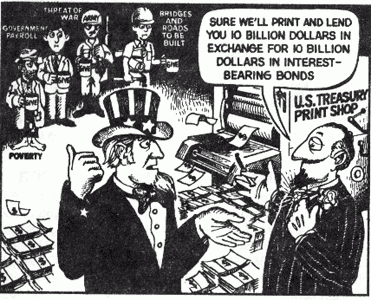How do privately owned banks fulfill their corporate mission to make a profit? They loan money for which they charge interest--10 percent interest equals 10 percent profit. So, let's say you borrow $1,000, the privilege for which you must repay the bank $1,100. Where do you get the extra $100? Well, from selling your goods or services to other people. True--but where do they get the money to pay you? Oh, yes--they borrow from the same bank, which, of course, charges them interest, too. Let's say a country has a population of one million people and each citizen borrows $1,000 from the bank to create an economy based on currency exchange. Collectively, the bank loans the country $1 billion in bank notes. In return, the country owes the bank $1 billion dollars for the loan's principal, plus another $100 million for the interest. So where does the country get the extra $100 million in currency to pay the bank? It doesn't. It can't. That's because the country can only borrow and repay money--not create it--and because only banks can create money. This issuing of a national currency solely by private banks results in a debt-based economy in which there is never enough money in circulation to pay both the principal and the interest. It's only through continual economic growth--and the demand for new loans--that enough money can be created to repay the original loan. In other words, borrowing can only beget more borrowing. Inevitably, the compounding of the debt leads to a situation in which creditor insolvency motivates banks to foreclose on loans. The debtor's property, used as collateral for the loan, is confiscated and distributed to the bank's shareholders. Because the money loaned by the bank was never equal to the value of the collateral, the shareholders happily accept foreclosures.
Lipton, Bruce; Steve Bhaerman (2009-08-31). Spontaneous Evolution: Our Positive Future (and a Way to Get There from Here) (pp. 303-304). Hay House, Inc. - A. Kindle Edition.





